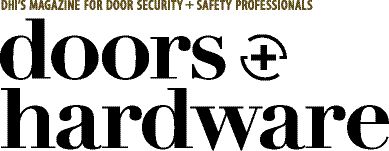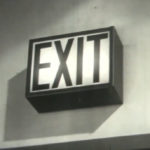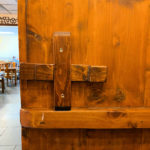Here’s my next Decoded article for Doors & Hardware…even though I write about panic hardware here on iDigHardware pretty frequently, it has been YEARS since I wrote about it in my Decoded column!
This post was published in Doors & Hardware
.
It has been a while (6 years!) since I have written about the code requirements that apply to panic hardware in my Decoded column, so it’s time for an update. There are several questions that come up fairly frequently, so I will address the following:
- Where is panic hardware required by code?
- When is a double-cylinder lock allowed instead of panic hardware?
- How is the actuating portion of panic hardware measured?
- What is the maximum force allowed for operating panic hardware?
- Can an electromagnetic lock be installed on a door that is required to have panic hardware?
- Is a non-latching sensor bar considered panic hardware?
First, some basics. Panic hardware is defined by the International Building Code (IBC) as: “A door-latching assembly incorporating a device that releases the latch upon the application of a force in the direction of egress travel.” Fire exit hardware is panic hardware that is listed for use as part of a fire door assembly. Panic hardware is required by the IBC and NFPA 101 – Life Safety Code to be listed in accordance with UL 305 – Standard for Panic Hardware. Fire exit hardware must be listed to UL 305 and is also required to be listed in accordance with UL 10C – Standard for Positive Pressure Fire Tests of Door Assemblies. A standard from the Builders Hardware Manufacturers Association (BHMA) also applies to panic hardware – ANSI/BHMA A156.3 – Exit Devices.
Panic hardware is designed so that a person or group of people attempting to exit can easily unlatch the door by pushing on the hardware in the direction of egress. Current designs for panic hardware include the touchpad, crossbar, and recessed styles, as well as tubular panic hardware which is often used on glass doors. The touchpad style is sometimes favored for durability and availability of electrified options, and crossbar devices may not be preferred for some locations because they can be chained together – preventing egress, but the model codes do not currently specify which of these types is required.
Where is panic hardware required by code?
The most common question I receive about panic hardware is whether it is required in a specific location. For example, in a building with multiple floors filled with office cubicles, or a large multi-family apartment building, would panic hardware be required on the egress doors? While there may be state or local requirements that vary, the IBC and NFPA 101 requirements are the ones that apply in most jurisdictions.
According to all editions of the IBC starting with the 2006 edition, panic hardware is required for doors serving 3 use groups:
- Assembly occupancies with an occupant load of 50 people or more
- Educational occupancies with an occupant load of 50 people or more
- High Hazard occupancies with any occupant load
These requirements apply to doors which lock or latch; they do not apply if a door has push/pull hardware and no lock or latch.
For facilities that are required to follow NFPA 101 – Life Safety Code, there are 4 occupancy classifications where panic hardware is required:
- Assembly occupancies with an occupant load of 100 people or more
- Educational occupancies with an occupant load of 100 people or more
- Day care occupancies with an occupant load of 100 people or more
- High hazard occupancies with an occupant load of more than 5 people
Note: There are additional requirements in NFPA 70 – National Electrical Code, for panic hardware on rooms housing electrical equipment and a requirement in the 2021 IBC for doors serving refrigeration machinery rooms. The requirements for these rooms are covered in this Decoded article and this code update.
Based on these code requirements, would panic hardware be required for an office building (Use Group B – Business) or multi-family apartment building (Use Group R – Residential)? If these buildings do not include a space that would be considered an assembly, educational, or high hazard occupancy, the answer is no – panic hardware is not required by the model codes. Of course, panic hardware can be installed for convenience, security, or durability, even if it is not required by code.
When is a double-cylinder lock allowed instead of panic hardware?
In certain occupancy types, the model codes allow the main door or doors to be equipped with a key-operated locking device on the egress side. A double-cylinder deadbolt is the most commonly-used hardware for this application, and the lock must be readily distinguishable as locked. Signage is also required on the egress side of the door, with 1-inch high letters on a contrasting background, stating “THIS DOOR TO REMAIN UNLOCKED WHEN THIS SPACE IS OCCUPIED.” The use of this type of lock can be revoked by the building official for due cause.
So where can this lock be used, and what does this have to do with panic hardware? According to the IBC, one of the locations where panic hardware is required – Group A (Assembly), is allowed to have a key-operated lock on the main door or doors in lieu of panic hardware if the occupant load is 300 people or less. Places of religious worship are also allowed to have a key-operated lock on the main door or doors, as well as Groups B (Business), F (Factory & Industrial), M (Mercantile), and S (Storage). The occupant load of these use groups is not limited by the section of the code which addresses key-operated locks. In previous editions of the IBC, the use of key-operated locks was restricted to the main exterior door or doors, but this was changed in the 2015 edition in order to allow this application to be used on retail stores within an interior mall. NFPA 101 also includes an exception for key-operated locks, with slightly different restrictions.
Note: A change was made to the 2021 IBC, which allows key-operated locks to be used on egress doors serving exterior spaces – there’s more info in this Decoded article.
How is the actuating portion of panic hardware measured?
The actuating portion of the panic hardware – the touchpad or crossbar – must measure at least one-half the width of the door, for example, an 18-inch touchpad for a 3-foot-wide door. This seems pretty clear, but another interpretation of the code language has emerged…the interpretation that the actuating portion must extend across the mid-point of the door. Since the actuating portion typically begins a few inches from the lock edge of the door, this interpretation would result in an 18-inch touchpad being code-compliant on a door that is more than 3 feet wide.
Without a prescriptive “starting point” in the model codes – a minimum dimension from the lock edge of the door where the actuating portion must begin, the alternative interpretation is inconsistent. The more prevalent interpretation is for the actuating portion to measure at least one half of the door width, and the 2018 edition of NFPA 101 includes a change that will help to clarify the intent of this requirement.
Prior to the 2018 edition, NFPA 101 stated: “It shall consist of a cross bar or a push pad, the actuating portion of which extends across not less than one-half of the width of the door leaf.”
Beginning with the 2018 edition, NFPA 101 states: “It shall consist of a cross bar or a push pad, with the length of the actuating portion of the cross bar or push pad not less than one-half of the width of the door leaf.”
What is the maximum force allowed for operating panic hardware?
Both the IBC and NFPA 101 include a requirement for panic hardware to be operable with a force of 15 pounds or less. Until 2010, the accessibility standards were silent on the operable force for hardware, but in the 2010 ADA Standards for Accessible Design, a reference to a paragraph addressing operable parts resulted in a requirement for hardware – including panic hardware – to operate with a force of 5 pounds or less.
This change in the ADA standards resulted in a conflict with the model codes, and difficulty with enforcement of the requirement. The accessibility standard referenced by the IBC – ICC A117.1 – Standard for Accessible and Usable Facilities, did not include a limit on operable force. However, the 2017 edition of the standard includes a limit of 15 pounds of operable force in a pushing or pulling motion, and 28 inch-pounds of rotational force. These limitations are included in the 2021 edition of the IBC as well. The ADA conflict will still exist, but may eventually be resolved by the US Access Board; until then, a maximum 5-pound force could apply in some jurisdictions, depending on the Authority Having Jurisdiction.
Can an electromagnetic lock be installed on a door that is required to have panic hardware? Is a non-latching sensor bar considered panic hardware?
In the 2009 edition of the IBC and NFPA 101, a section was added that addressed electromagnetic locks released by door-mounted hardware – panic hardware or a lever handle that incorporates a request-to-exit switch, or a sensor bar. The 2009 IBC included confusing language stating that this application could be used on doors where panic hardware was not required. After publication of this edition, it was determined that it was not the intent of the proposal to prohibit the use of mag-locks on doors with panic hardware. The code section was later clarified to allow this application on doors with panic hardware, as long as a switch in the panic hardware released the mag-lock to allow egress. The code sections which address mag-locks released by a sensor instead of door-mounted hardware do not prohibit the use of this application on doors with panic hardware. There is more on this topic in this blog post.
In order to be considered panic hardware, a product must be listed in accordance with UL 305. This standard includes tests that involve latching, so a sensor bar that does not incorporate a latch can not be listed to this standard. This means that if panic hardware is required by the model codes, doors which lock or latch would not be allowed to have a non-latching sensor bar in lieu of panic hardware.
Conclusion
As the requirements for panic hardware can vary from one edition of a model code to the next. It’s important to be aware of the specific code requirements that have been adopted in a project’s jurisdiction. There are additional requirements that apply to panic hardware, for example, the mounting height (34 inches to 48 inches above the floor), and the prohibition on other locking devices used in conjunction with panic hardware. Electrified hardware applications which involve panic hardware may also have requirements defined in the model codes. When in doubt, refer to the adopted codes or discuss the situation with the Authority Having Jurisdiction. Rectifying a panic hardware compliance problem can be an expensive proposition.
You need to login or register to bookmark/favorite this content.










Very good
I always need a refresher
Thank you for covering the 2009 language
Awesome. Thank you for this concise guide. I’ll refer people to it often.
May I post this article in our inspector’s magazine?
Of course!
– Lori
In both the 2009 ICC A117.1 (404.2.8) and 2010 ADA Standards (404.2.9) the 5.0 pound opening force requirement applies to 1) interior hinged doors and gates; and 2) sliding or folding doors. This force does not apply to the force required to retract latch bolts or disengage other devices (i.e. acoustical seals, sliding door weather stripping) The 5.0 pound opening force is not required at fire doors or exterior hinged doors. Fire doors shall have the minimum opening force required by the appropriate administrative authority. Exterior hinged doors need to comply with force requirements of 2015 IBC 1010.1.3 — door latch release and door swing to opening position using a 15 pound force and door set in motion when subject to a 30 pound force.
Thanks Dave. This information is covered in a different Decoded article: http://idighardware.com/2012/05/decoded-opening-force-and-closing-speed/. But the 2010 ADA standards do require the hardware to unlatch with 5 pounds of operable force. Here’s some more info on that: http://idighardware.com/2014/03/decoded-operational-force-for-door-hardware/.
– Lori
Great information. As I have always taught my fellow hardware people when in doubt always err on the side of life safety . So if you don’t think a lever passage latch set is good enough go ahead put on a panic exit device . You may have to discuss this with the person or persons footing the bill but at least you’re providing the best solution for life safety .
Great information… and it is very helpful for me to better understanding the requirements. Unfortunately it doesn’t cover the area of my concern. thanks, Joe
Keep up the good work.
Hi Joe –
If there is something I can help you with, feel free to email me at lori.greene@allegion.com.
– Lori